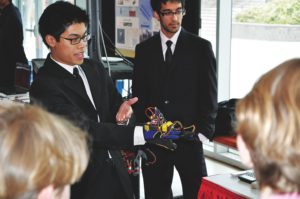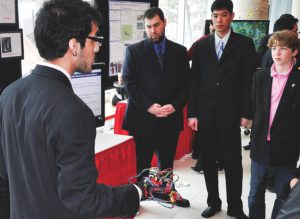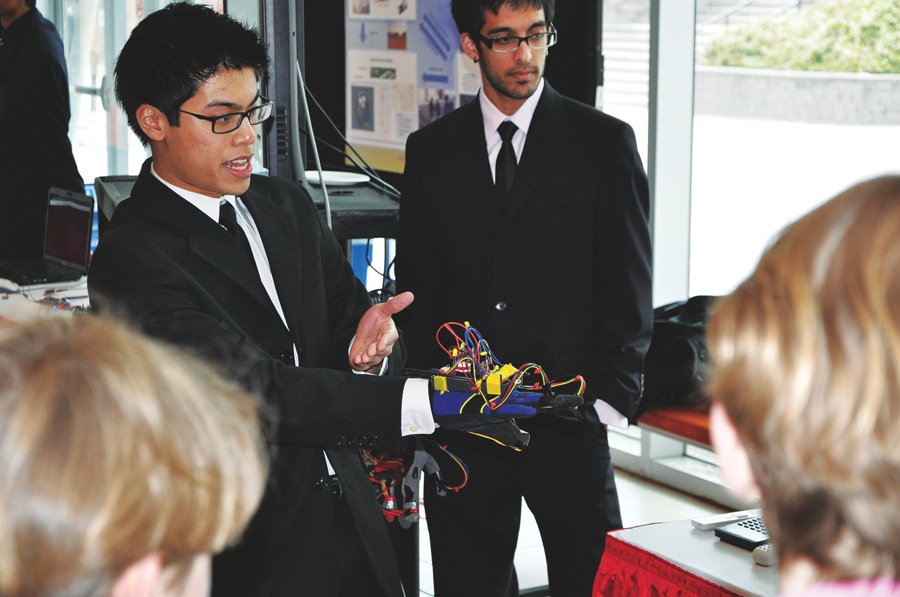Ernest Reid
Science & Technology Editor
A team of York engineering students have been recognized for their research into human-computer interaction. Their e-Glove, a gesture interface device, won second place at the annual ENG 4000 competition held on April 21. Their device functions as a wearable remote controller; instead of buttons to turn appliances on or off, the e-Glove uses hand-gestures.

Organized by Professor G. Zhu for York’s School of Engineering and held here at York, seven teams were judged on innovation, engineering design and product presentation. The group behind the e-Glove, the SYNC Engineering team, is composed of Steve Low, Yan Ying Fang, Niken Goswami and Chris Carmichael.
The first-place winners were Team Aerodines, with their flight stablizing system for an unmanned aircraft. The third-place winners were the iRobo team, recognized for a smartphone-controlled robotic vehicle.
SYNC Engineering argues that households are overpopulated with remote controllers; they estimate the average home has 10 to 15, with many thrown out every year. Low, the project manager, explains that the team’s device is “not just a universal controller.”
“We wanted to expand the range [of the e-Glove] over a diverse range of devices,” such as a picture frame or a thermostat, says Low. The group hopes to offer new and natural ways of interaction with all electrical appliances using hand gestures.

Their e-Glove takes the technology of the remote control and attaches it to the user’s hand. Their website explains that “when a push-button is pressed on a remote controller, it generates an IR [infrared] signal to the device. Pressing different buttons would generate different IR codes.” Instead of assigning buttons to IR codes, the e-Glove assigns different hand movements to different infrared signals.
A benefit of infrared technology, Low points out, is that you have to be in front of the signal receiver for it to work. If an e-Glove wearer uses a natural gesture in the other room, they don’t have to worry about their oven turning on. While IR technology can be imprecise, this can be a blessing when unconscious movement is a risk.
Low laughs when asked if we should live in a world without remote controllers. It seems the team believes we shouldn’t be satisfied with push-button user
interfaces.
SYNC argues there are no consistent standards in the industry for push-button user interface and no single product can handle multiple sets of devices—universal remotes might be programmed for TVs and stereos, but what about household lighting or car dashboards?
Push-button remotes also have several design flaws—the more remotes you have, the more difficult it becomes to distinguish their functions. The SYNC team is also concerned with the excess of the interface. With the remote controller, users are given more buttons than they frequently use. The TV remote has multiple functions on one interface but very few of them are used frequently.
Low uses his parents as his example. “My dad will never use the constrast button,” Low says, “but he will be using channel and volume changes consistently. With an aging boomer population, a gesture interface glove might be popular with users who desire minimal, consistent and natural connections with their technology.
At the centre of SYNC’s e-Glove project and other gesture interface technologies is a more physical connection to our appliances. Remote controllers separate consumers from the products they use; gesture interfaces allow them to handle electronics from a distance. While still in the extreme prototype phase, SYNC Engineering hopes to cheaply streamline the device and create a closer intimacy with our technology.
Engineering team gestures towards future


